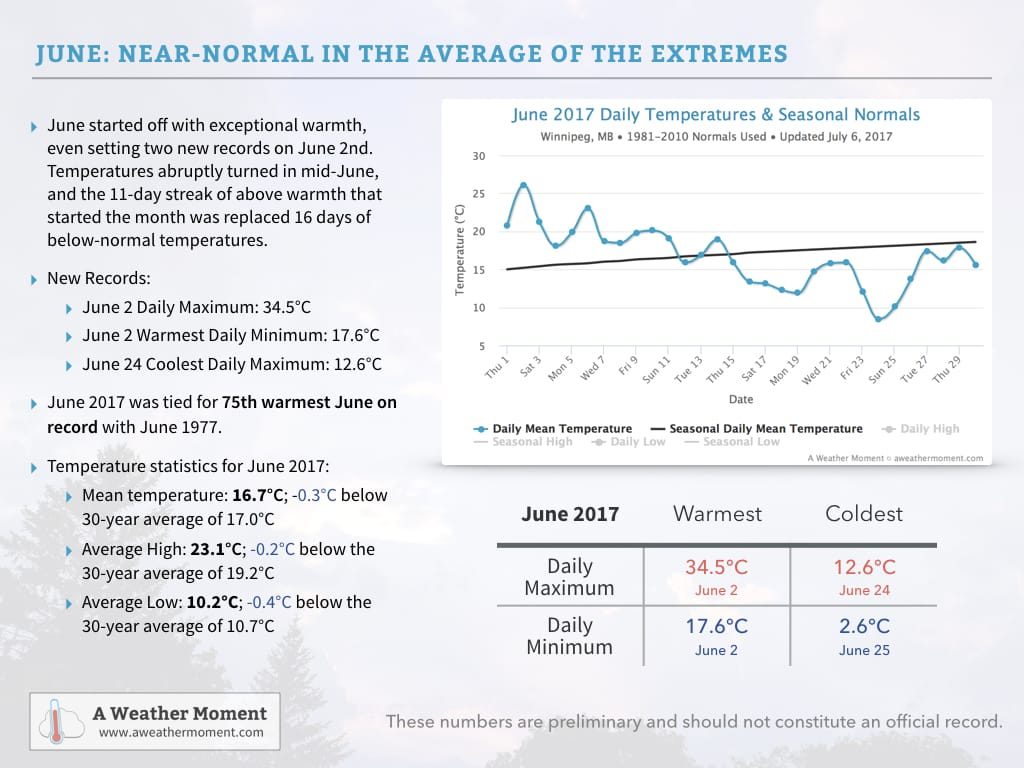July 2017 spent much of it’s time with below normal temperatures — 16 of 31 days had daily mean temperatures below the 30-year average — but was still generally pleasant with much fewer days of rain than in June and many daytime highs that were close to seasonal values.
The first third of July consisted of a swing from well below-normal temperatures to well above normal temperatures followed by a brief period of near-normal temperatures. The deviations from normal more-or-less cancelled each other out with a month-to-date departure from normal of -0.2°C by July 10th. For the next 14 days, though, Winnipeg fell into a prolonged period of below normal temperatures with daily means generally 1.5 to 2.5°C below normal. By July 23rd, Winnipeg’s month-to-date departure from normal had fallen to -1.2°C. The end of the month saw an abrupt turnaround, though, as hot and humid weather moved into the region. Several days saw high temperatures in the upper 20’s to low 30’s and overnight lows in the mid- to upper-teens.
No record temperatures were set in July, however.
By the end of the month, the warm spell had allowed the monthly mean temperature departure from normal to recover to -0.4°C.
In other temperature statistics:
- July 2017’s average high temperature was 25.7°C, just -0.1°C below the 30-year average of 25.8°C.
- July 2017’s average low was 12.5°C, -0.8°C below the 30-year average of 13.3°C.
Near-Seasonal Rain at the Airport
While there was only rain on 8 of 31 days in July, total rainfall ended up near-normal with 71.1 mm.
While it rained infrequently, the Winnipeg airport measured a total of 71.1 mm of rain through July 2017, 90% of 30-year normal of 79.5 mm. Much of the rain fell on just 3 days: July 11 (21.7 mm), July 21 (14.1 mm), and July 22 (14.3 mm). The combined 3-day total of 50.1 accounted for 70% of the month’s rainfall.
The 8 days of measurable precipitation was a welcome improvement from June which saw 14 days of measurable precipitation. The concentration of the bulk of the rain into just 3 days did make for some drying, though, and some gardeners likely needed to begin watering their plants occasionally again.
It is worth noting, however, that rainfall was variable throughout the city. At my Glenwood personal weather station I measured slightly less at 68.6 mm. Some locations over south and eastern Winnipeg saw as little as 50-55 mm while other locations across the west side of the city saw up to 85 mm.
So in the end, July 2017 was a very nice rebound from June. There were few days with rain, quite a few days with near-seasonal highs and a lack of humidity that brought more frequent slightly below-normal temperatures at night.
August seems to be continuing the trend so far with near-seasonal highs and cooler nights courtesy a lack of humidity. No complaints from this author!
Unless otherwise noted, all normal values referred to in this post use the 1981-2010 normals for Winnipeg, Manitoba.

